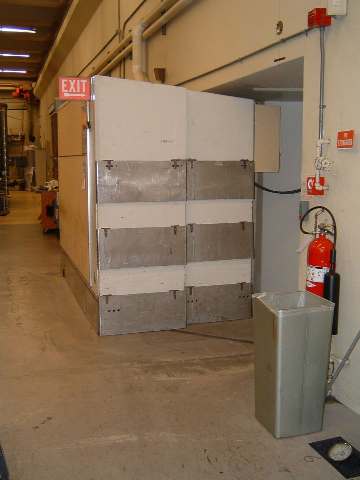
I'm fortunate enough to work as a computer systems manager at the University of Washington's Center for Experimental Nuclear Physics and Astrophysics, formerly known as the . Nuclear Physics Lab
Part of the equipment we have here is a van de Graaff accelerator, capable of creating precisely controlled beams of charged particles (ions, which are atoms with a few extra, or a few too few, electrons) which we can smash into other atoms to catch glimpses of the shattered pieces produced, from which to verify or refute our theoretical knowledge of the fundamental construction of barious bits of the universe.
Ions are created by adding electrons to the outer orbital shells of atoms.
We do this in many ways, some of them are done on a platfrom raised 300,000 volts above ground potential. That imparts a desire on the part of the ions to move toward the ground potential end of the van de Graaff.
Here are the high-voltage diode stacks, with the three-phase 300 KV transformer in the background.

The platform stands above the building's floor on ceramic insulators.

The cage contains normal electronic gear... since it's all "elevated" to 300,000 volts, the gear doesn't know about the high voltage.
To protect people, it's behind a locked metal cage when in operation, and grounding hooks are attached when not in use to avoid accidents if it were ever turned on.

From the cage, the feeble stream of ions travels down a 4-inch diameter
aluminum pipe (the "beam tube"), which otherwise contains a vacuum.

The beam enters the "low energy" end of the 40-foot long van de Graaf bottle.

The steel vessel is full of compressed CO2, which serves as an insulator. The accelerator itself was purchased "off the shelf" from High Voltage Engineering of Burlington, Massachusetts.
It's their model "FN", if you'd like one.

[someday there'll be a "how it works" added here]
The beam, now moving rather quickly, exits the High Energy end of the van de Graaff.

Where it enters a switchyard of beam pipes. Experiments for which 18 MeV is enough, just go straight, take a 90 degree left turn, and go into the experimental areas.

Experiments requiring faster/higher-energy beams take a jog and head into the bank of cryostats containing the elements of a 36-stage superconducting Linear Accelerator

At the end of that row of cryostats, a set of magnets and focusing coils turn the beam in a U-turn and send it down a second row of cryostats.

After the acceleration, the beam passes through a wall. This is one of the six-foot-thick doors used for human passage through the wall.

We have two target rooms, each with a different assortment of target types, manipulators and detection equipment. This is our "ten inch target" area, with lead "pigs" shielding the sensitive detectors. The pigs are supported on air-bearings (like an air hockey table) to allow easy positioning on the cast-in-place epoxy floor.

the other target room is larger, with more equipment.
One item is a ten-ton series of magnets, called the "Momentun Filter".
They are mounted on a surplus World War II battleship gun-turrent mount.
They act like a glass prisim... given a specific magnetic field, the charged particles from the collision will either be bent strongly enough
to hit the sides of the beam tube, or will be going to fast to be bent, and will also hit the sides of the tube. The particles we are interested in will bend just enough to pass through the tube and hit the final detectors.

That same room contains three other beam pipes, and which one receives
the beam is controlled by another magnet on the van de Graaff side of the wall.

Perhaps the most flexible target holder is this five-foot-wide vacuum container. It has remotely controlled arms to position detectors at
any angle relative to the target mounted in its center. Low energy particles will rebound back towards the van de Graaf, whereas high energy (or high mass , kicked by the beam) will exit on the side away from the incoming beam.

To operate that entire mess requires a lot of AC power... this is one small portion of our power distribution and circuit breaker panel.

======================
..the tour, continued